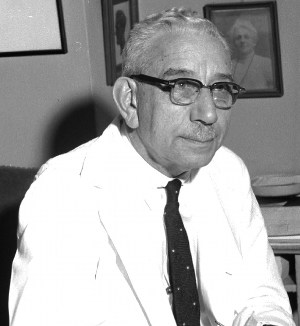Burrill Bernard Crohn facts for kids
Quick facts for kids
Burrill Bernard Crohn
|
|
|---|---|
 |
|
| Born | June 13, 1884 |
| Died | July 29, 1983 (aged 99) |
| Nationality | American |
| Alma mater | College of Physicians & Surgeons – Columbia University – Class of 1908 |
| Known for | Crohn's disease |
| Scientific career | |
| Fields | Gastroenterology |
| Institutions | Mount Sinai Hospital, New York |
Burrill Bernard Crohn (born June 13, 1884 – died July 29, 1983) was an American doctor who specialized in the digestive system. He is famous for helping to identify a disease now called Crohn's disease. This disease affects the digestive system. Dr. Crohn spent his long career helping patients and researching many conditions of the stomach and intestines.
Contents
Early Life and Education
Burrill Bernard Crohn was born on June 13, 1884, in New York City. His parents, Theodore and Leah Crohn, were Jewish immigrants from Europe. He grew up in a large family with 11 brothers and sisters.
Crohn went to City College of New York and earned his first degree in 1902. He then studied medicine at Columbia University College of Physicians and Surgeons, getting his medical degree in 1907.
Discovering Crohn's Disease
After medical school, Dr. Crohn started working at Mount Sinai Hospital in 1907. By 1920, he became the head of the gastroenterology department. This department focuses on diseases of the stomach and intestines.
In the early 1930s, Dr. Crohn and his colleagues, Leon Ginzburg and Gordon Oppenheimer, noticed something new. They found 14 patients with similar symptoms and problems in their intestines. These problems didn't match any known disease at the time.
In 1932, they wrote an important paper describing this new condition. It was called "Regional Ileitis: A Pathologic and Clinical Entity." This work helped doctors understand that this was a specific inflammatory disease of the digestive tract, not a form of tuberculosis as some thought. Even though Dr. Crohn preferred the name "regional ileitis," the disease soon became known as "Crohn's disease" in his honor.
Research and Career
Dr. Crohn was very curious about what caused Crohn's disease. He thought it might be caused by a type of bacteria called Mycobacterium paratuberculosis (MAP). This bacteria causes a similar disease in cattle called Johne's disease. However, he couldn't find the bacteria in humans at the time. Today, with better tools, scientists are looking into this idea again.
For most of his career, Dr. Crohn had a private medical practice in New York City. He worked closely with Mount Sinai Hospital. He became a very successful doctor, helping many patients with inflammatory bowel disease, including Crohn's disease.
In 1932, he was chosen to be the president of the American Gastroenterological Association, a major group for doctors who study the digestive system. He received many awards and wrote more than 100 articles for medical journals. He also wrote three books: Affections of the Stomach (1927), Understand Your Ulcer (1943), and Regional Ileitis (1947).
Dr. Crohn even advised important people, including President Dwight D. Eisenhower, in 1956. He once said he became a doctor because he wanted to help his father, who had severe indigestion.
Personal Life and Hobbies
Burrill Crohn married Lucile Pels in 1912. They had two children, Edward and Ruth. They later divorced in 1927. He then married Rose Blumenthal in 1948.
Outside of medicine, Dr. Crohn had other interests. He enjoyed painting and studying the history of the American Civil War. His watercolor paintings were often shown in art galleries in New Milford, Connecticut.
Dr. Crohn continued to practice medicine until he was 90 years old. He divided his time between his home in Manhattan and a country home in New Milford, Connecticut.
After his death, the Burrill B. Crohn Research Foundation was created at Mount Sinai Hospital in 1983. This foundation helps fund research into Crohn's disease.
See also
 In Spanish: Burrill Bernard Crohn para niños
In Spanish: Burrill Bernard Crohn para niños

